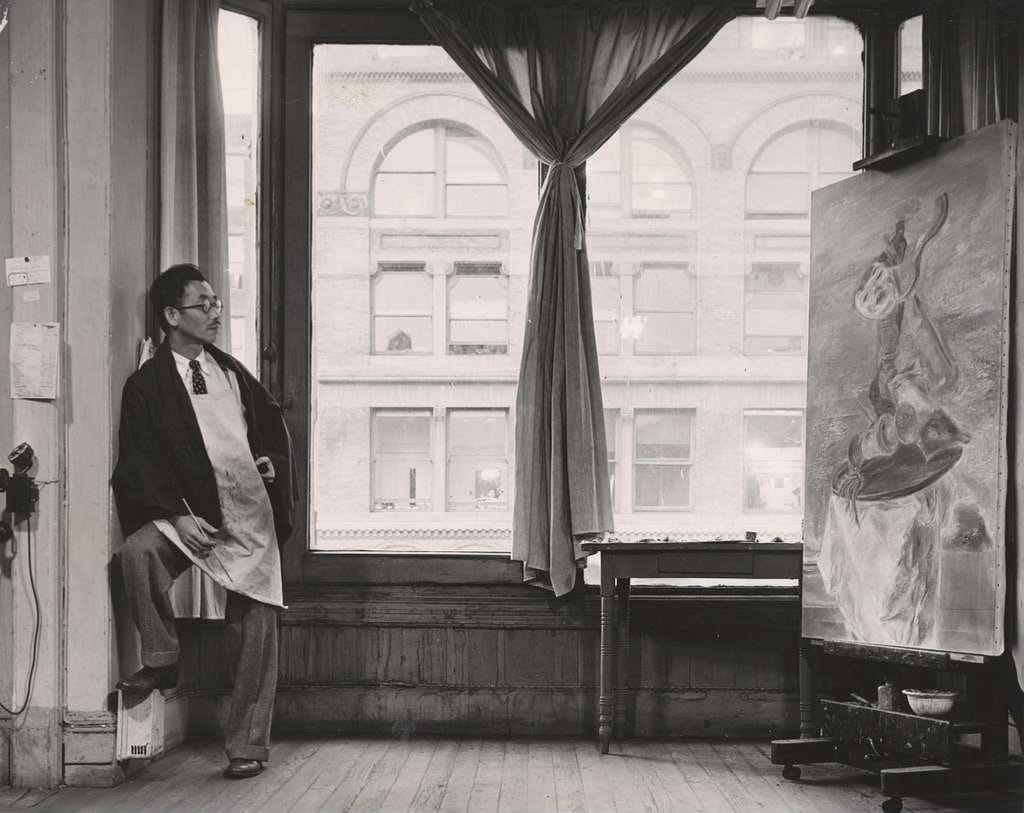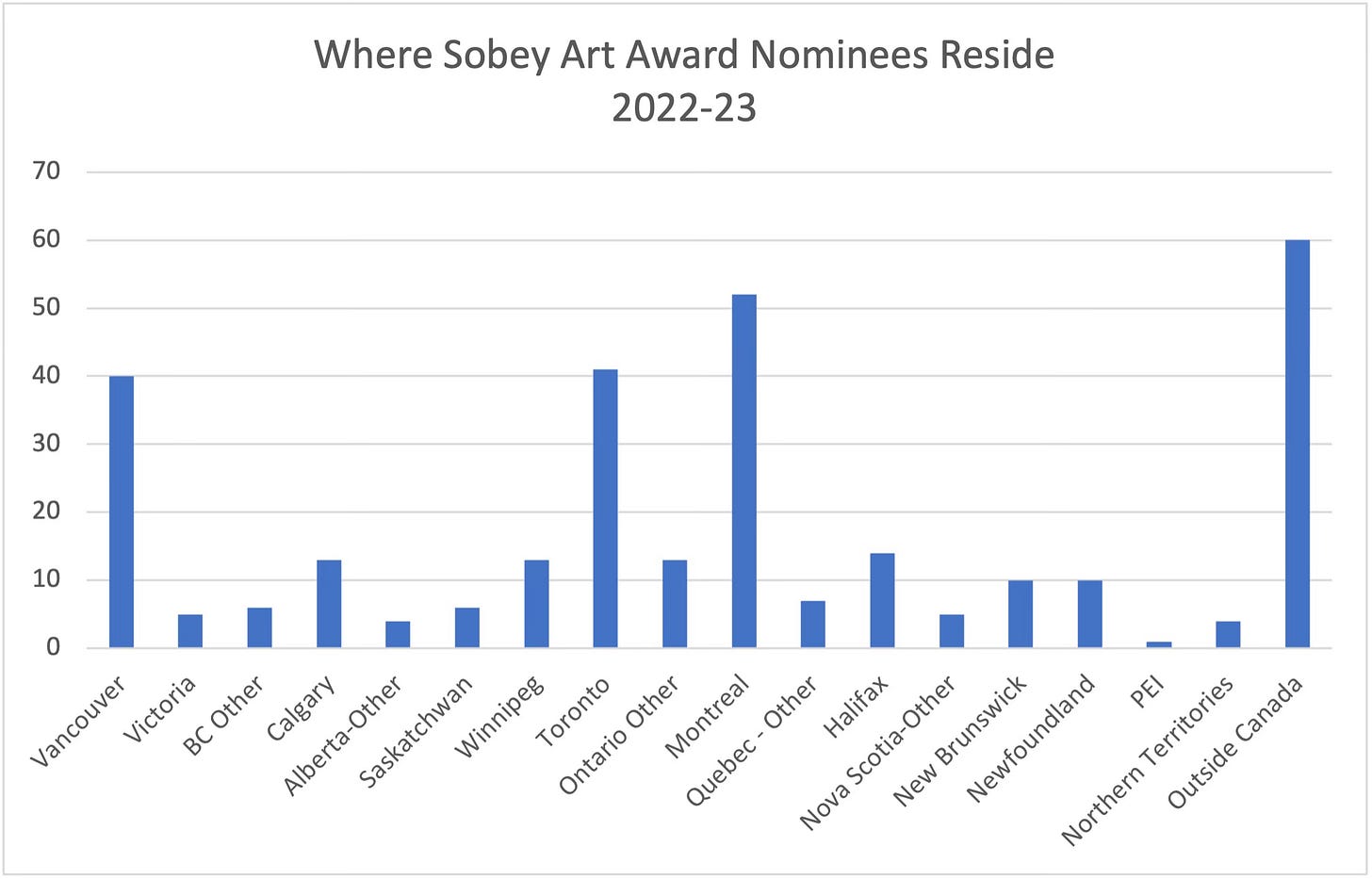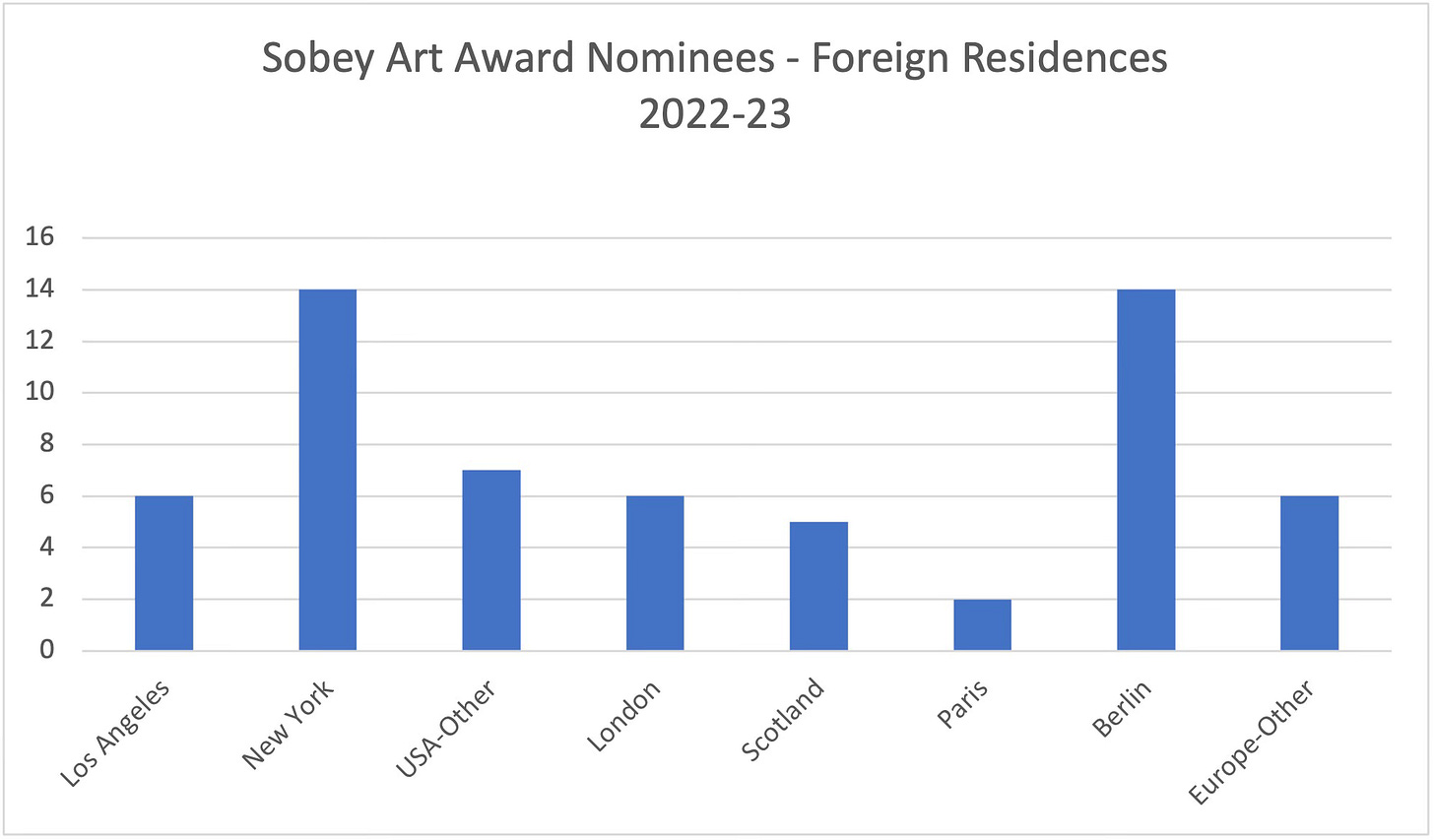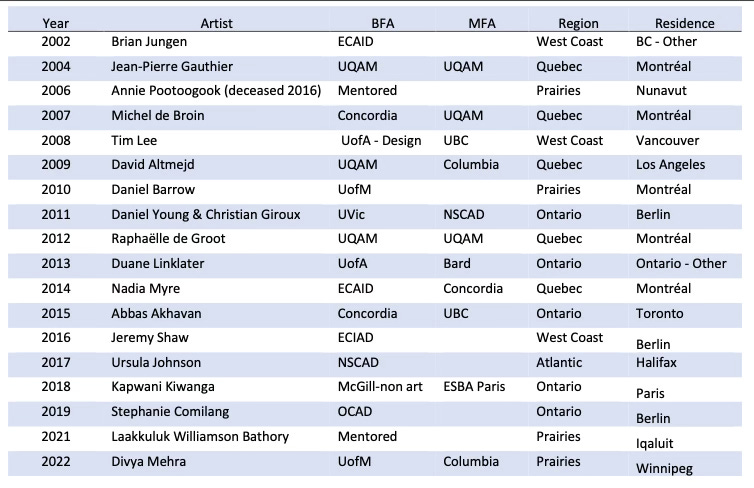
In this post I continue my exploration of the Sobey Art Award data to see what it can tell us about contemporary art in Canada and beyond.
When I attended art college, the mantra was that any serious artist in Canada would have to move to New York to truly succeed in the Art World. Graduates of Alberta College of Art in Calgary (now Alberta University of Art), like Evan Penny and Christian Eckart, were spoken of with awe; they had moved to New York and made it. Today, the Art World is different. The centres of power are dispersed and communication and travel have changed immensely since the 1980s. So is it still necessary to move to New York, or London, or Paris, or Berlin to be recognized as a contemporary artist? In other words, does it matter where an artist lives and works?
To explore this question I studied the list of Sobey Art Award nominees and the winning results from 2002 to 2022. The Sobey Award is designed to fairly represent all artists from across Canada. Each year, five artists are chosen from five regions across the country and the jury is composed of a curator from each of these regions along with one or two international art professionals. This equalizing structure of regional representation means that every year one artist from each region is recognized and celebrated through their inclusion on the shortlist. Over the twenty-year period, however, each region has not had an equal share of the final win. Artists from Québec and Ontario have won the prize most often with five winners each. The Prairies & The North have had four winners, the West Coast & Yukon three, and only one artist from the Atlantic region has won the award in the entire twenty years.1 This suggests that artists from Ontario and Québec may have an advantage over artists from other regions, especially artists from the Atlantic provinces.
To understand this result in more depth, I tracked the current (2022-23) residence of each of the 310 Sobey nominees.2 Confirming the residences of the nominees, however, had its challenges. To be nominated for the Sobey Art Award an artist must have been born in Canada or be a Permanent Resident. This would require that an artist has, at one time, lived somewhere in Canada. Thus, where an artist lives at the time of nomination would usually dictate which region of the country the artist would represent. The nomination rules, however, are not clear about artists who are Canadian but not living in Canada. Kapwani Kiwanga (2018 winner ), for example, was living in Europe at the time of her nomination and continues to live in Paris. She was born and raised in Hamilton, Ontario then studied in Montréal before moving to Europe. Kiwanga was nominated to represent Ontario likely because of her familial connection with that region.3 Regional designations are then not necessarily indicative of where an artist actually lived at the time of nomination. These designations, however, still provide a constructive baseline for considering how artists migrate within Canada and beyond.
As the chart indicates, the largest number of nominees now make their homebase in one of Canada’s three largest urban centres with Montréal taking the lead followed by Toronto and Vancouver. Several smaller cities such as Calgary, Halifax, and Winnipeg also figure strongly as places where there is a concentration of nominee-artists. An even larger group of artists (19 %) live outside of Canada choosing New York, Berlin, London, and Los Angeles as their favoured locations.
To understand this migration within Canada and beyond, I compared the region in which the artist was nominated with the region of their current residence. This data indicates that 30% of the 310 artists migrated from the region in which they were nominated. The region with the lowest migration rate is Québec where only 14 of 62 artists (23%) left the region for other locations. The West Coast & Yukon had similar numbers with only 18 out of 65 artists (27%) leaving the region.
Over half of the 14 artists migrating from Québec relocated to Europe and the United States with the majority (6) choosing a European location rather than the United States. In Canada, three artists moved to Toronto while one settled in the Atlantic region. West Coast artists also favoured foreign locations with the majority of artists (12) migrating to Europe – Berlin, London, and other European locations. The few artists that migrated within Canada relocated to Montréal (2) and Toronto (4).
At 39%, the Prairies & North region had the most out-migration. Prairie artists migrated to diverse locations with just over half (13 of 24) leaving Canada for various places in the United States and Europe. Their movement within Canada was equally diverse and included Montréal, Toronto, Vancouver, and Nova Scotia.
Ontario and the Atlantic regions had similar migration rates at 34% and 33% respectively. A strong majority of migrating artists from Ontario (83%) relocated to foreign locations with the majority choosing the United States including New York City, Los Angeles, and other locations. In Europe, London and Berlin were favoured. Only four artists moved within Canada, going to Montréal and Vancouver.
The Atlantic region is the only region that did not have a majority of artists who favoured foreign re-location. Only six out of 18 artists moved to foreign locations which include London and New York. The majority of migrating artists stayed within Canada: three to Montréal, five to smaller cities like Guelph and Hamilton in Ontario, two to Vancouver, and one to Calgary.
The reasons for artists migrating is not clear from the available data. The artists may have travelled from their home region to study or take up employment. Others may have chosen to move to a location with a more vibrant and active artistic culture. The number of artists relocating and settling in large urban centres like Montréal (52), Toronto (41) and Vancouver (40) in Canada and Berlin (14) and New York (14) suggests that these cities offer artists greater opportunities for recognition in the contemporary art world. The Sobey winner’s list reinforces this perception. Five of the 18 winners made their residence (at the time of nomination or later) in Montréal and another five made their residence outside of Canada with Berlin being the favoured location for three artists. In total, over half of the winners (12) reside in one of Canada’s larger cities and in artistic centres outside of Canada.
Considering the outcome of this one small study of migrating artists, it would appear that New York is no longer the primary international centre of contemporary art and that Berlin has become a major contender as an artistic centre. In 2001, Marina Sorbello remarked in The Art Newspaper that “since the fall of the Wall, Berlin has established itself as the artists’ capital.”4 Cheap rent, multiple public and private museums, numerous top-rated commercial galleries, government funding, significant art events and paid residencies open to foreign artists have all made this city an appealing location. Canadian artist, Cedric Bomford, for example, was living in Berlin when I met him in 2008. When asked why he and other artists were attracted to this German city, he explained that in Berlin artists had direct contact with the international contemporary Art World. Important curators – those agents who select artists for biennales, festivals, and exhibitions – were known to visit local studios, giving the artists an immediate connection to an Art World that would be far out of reach in most locations in Canada.
In Canada, Montréal rather than Toronto or Vancouver appears to be claiming the position of premier art centre. Of the three centres, Montréal has consistently nurtured an artistic culture through extensive funding and capital investment that has often outranked Toronto and Vancouver.5 In 2008, Sara Milroy, the art critic for the Globe & Mail made note of the growing significance of Montréal as an artistic centre. In her review of the Québec Triennial, she suggests that Montréal had become the “real art capital of Canada” and explained the transformation this way:
First, you have to credit the strong art schools in Montréal and Quebec City. Looking at the CVs of these artists, one sees most of them are homegrown talents trained at Concordia University or the University of Quebec at Montréal [UQAM]. (Just a handful have gone on to hone their skills at places like Cal Arts or Columbia in the United States or Goldsmiths in London.) These programs, coupled with the viability of Quebec's artist-run-centre scene and the highly charged political push for cultural integrity over the past several decades – plus the critical funding for the museums to support it – have clearly given extra momentum to the province's artistic production.
With all its vitality and freshness, the show [the Quebec Triennial] leaves one with the unmistakable impression of Montréal's ascendancy. Quebec artists are emerging now knowing who they are, apparently not seeking validation from elsewhere to feel empowered.6
My studies of the Sobey Art Award nominees appear to reinforce this view of Montréal as Canada’s cultural capital.7 Concordia University was the top-attended university among the Sobey nominees over twenty years and UQAM (Université du Québec à Montréal) also had strong numbers. On the winners’ list, five of the winners studied at Concordia and/or UQAM for their undergraduate or graduate degree or both. Five of the 18 winners also now live in Montréal.
While 60 Sobey nominees make their residence outside of Canada there is still a strong majority of artists who continue to live and work in Canada (81%). These artists have also gained recognition in the international world of contemporary art despite their choice of residence. This would suggests that it is not absolutely necessary to move to an artistic centre. The Art World has expanded and now touches down in more cities around the globe. Art fairs and events like triennials and biennials bring the Art World to these places and the internet and modern communications make them, and the participating artists, known around the globe. With its regional focus the Sobey Art Award contributes to this recognition. Through its twenty years it has brought artists from every region of Canada into view. Even if these artists did not win the top prize, their nomination introduced them into the circles of recognition that are necessary for becoming a contemporary artist.
There were only 18 winners of the Sobey Art Award in its twenty-year history. The award was initially given out every two years and then became an annual prize in 2006. No single winner was chosen in 2020 because of the Covid pandemic. Instead the award was shared equally among the 25 longlisted artists. This results in 18 winners from 2002 through 2022.
Every year 25 artists and collectives have been nominated but some artists have been nominated more than once over the twenty-year period. When duplicates are removed there are 310 artists or collectives. The current residences of the nominees artists was determined by the most recent information available on internet sources such as artists’ websites, gallery websites, and Sobey Art Award sites.
Some artists list a location in Canada and a foreign location as their residence. In these cases, I documented the foreign residence as their residence.
Marina Sorbello, “Since the fall of the Wall, Berlin has established itself as the artists’ capital” (2001/November 8, 2019), https://www.theartnewspaper.com/2019/11/08/since-the-fall-of-the-wall-berlin-has-established-itself-as-the-artists-capital.
Kelly Hill, Mapping artists and cultural workers in Canada's large cities : Cartographie des artistes et des travailleurs culturels dans les grandes villes du Canada (2010) https://policycommons.net/artifacts/1190713/mapping-artists-and-cultural-workers-in-canadas-large-cities/1743836/ and Kelly Hill, Municipal Cultural Investment in Five Large Canadian Cities: A study prepared for the City of Vancouver, the City of Calgary, the City of Toronto, the City of Ottawa and the Ville de Montréal(Hill Strategy Research, 2012) https://policycommons.net/artifacts/2168891/municipal-cultural-investment-in-five-large-canadian-cities-a-study-prepared-for-the-city-of-vancouver-the-city-of/2924577/.
Sarah, Milroy, “Is Montreal the real art capital of Canada?” The Globe & Mail (May 30, 2008). http://www.theglobeandmail.com/servlet/story/RTGAM.20080530.quebec31/BNStory/Entertainment/home
See my previous articles: https://makingandmeaning.substack.com/p/sobey-art-award-and-canadian-contemporary, https://makingandmeaning.substack.com/p/diversity-in-canadian-contemporary, https://makingandmeaning.substack.com/p/becoming-a-contemporary-artist,https://makingandmeaning.substack.com/p/becoming-a-contemporary-artist-c53







My thoughts too.
Very interesting re Montreal. I wonder how Premier Legault's new tuition polices on English schools in Montreal (including Concordia) may be impacted by this. It will become more expensive and there will be a learning French requirement I think. Would be good to look at these numbers over the next five years or so and see if this changes. Thanks Marie - for your great research!